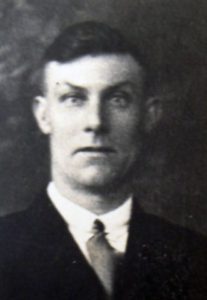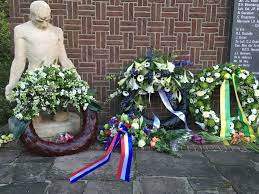Sijkel, Johan Aaldrik “Han”, born 08-10- 1911 in Rotterdam,  studied English at the University of Amsterdam where he was involved in the resistance against fascism; from Portugal he took part in resistance actions against Franco during the Spanish Civil War (1936-1939).
studied English at the University of Amsterdam where he was involved in the resistance against fascism; from Portugal he took part in resistance actions against Franco during the Spanish Civil War (1936-1939).
Stijkel was good friends with Jhr. Leonhard Schorer  the driving force behind the Netherlands Scientific Humanitarian Committee, the first Dutch organization that campaigned for equal rights for homosexuals. On 10-05-1940 he helped, together with Henri François, Jhr. Schorer in destroying its archive and membership administration. Shortly afterwards he started to set up a group to fight the German occupier. This group probably consisted of about eighty people, including Major General Hendrik Dirk Stephaan Hasselman,
the driving force behind the Netherlands Scientific Humanitarian Committee, the first Dutch organization that campaigned for equal rights for homosexuals. On 10-05-1940 he helped, together with Henri François, Jhr. Schorer in destroying its archive and membership administration. Shortly afterwards he started to set up a group to fight the German occupier. This group probably consisted of about eighty people, including Major General Hendrik Dirk Stephaan Hasselman, 
 as well as students, officers and entrepreneurs. Stijkel’s pseudonym was Dr. Ireland de Vries. The to J.A. Stijkel mentioned Stijkelgroep was aimed at transferring information about the German occupation to England. The necessary ‘beginner mistakes’ were made, as a result of which the occupier started to follow the resistance group. The resistance group, named after him, was in fact a first OD (Order Service) with the aim of filling a possible authority vacuum after the departure of the German occupiers and thus guaranteeing an undisturbed return of the Queen. The Stijkelgroep probably consisted of no more than 80 persons, including prominent persons from administrative circles in The Hague, including Major General Hasselman, students, officers and entrepreneurs. An active core group was located in the Zaan region.
as well as students, officers and entrepreneurs. Stijkel’s pseudonym was Dr. Ireland de Vries. The to J.A. Stijkel mentioned Stijkelgroep was aimed at transferring information about the German occupation to England. The necessary ‘beginner mistakes’ were made, as a result of which the occupier started to follow the resistance group. The resistance group, named after him, was in fact a first OD (Order Service) with the aim of filling a possible authority vacuum after the departure of the German occupiers and thus guaranteeing an undisturbed return of the Queen. The Stijkelgroep probably consisted of no more than 80 persons, including prominent persons from administrative circles in The Hague, including Major General Hasselman, students, officers and entrepreneurs. An active core group was located in the Zaan region.
Han Stijkel had been ordered by the government in London, among other things, to unite the resistance groups that had arisen throughout the country. To this end, he and members of his group traveled across the country. Stijkel used the pseudonym Dr. Eerland de Vries. The resistance group collected espionage data from military installations in IJmuiden and Rotterdam.  In the initial phase of the occupation, this work was extremely difficult due to the lack of supporting organisations, such as the Persons’ Certificates Central, which made false identity cards, making ‘beginner’s mistakes’ so that the German authorities in The Hague got their sights on the resistance group. The Germans let the traitor Anton van der Waals
In the initial phase of the occupation, this work was extremely difficult due to the lack of supporting organisations, such as the Persons’ Certificates Central, which made false identity cards, making ‘beginner’s mistakes’ so that the German authorities in The Hague got their sights on the resistance group. The Germans let the traitor Anton van der Waals  infiltrate the group. Antonius van der Waals (Rotterdam, 11-10-1912 – Scheveningen, 26-01-1950) was a spy for the German Sicherheitsdienst (SD) during the war. He made at least 83 victims and played a leading role in the Englandspiel, which cost the lives of many Dutch secret agents from England. Waals age 37, was sentenced to death and executed on the Waalsdorpervlakte
infiltrate the group. Antonius van der Waals (Rotterdam, 11-10-1912 – Scheveningen, 26-01-1950) was a spy for the German Sicherheitsdienst (SD) during the war. He made at least 83 victims and played a leading role in the Englandspiel, which cost the lives of many Dutch secret agents from England. Waals age 37, was sentenced to death and executed on the Waalsdorpervlakte  on 26-01-1950. Through a police organization, Stijkel comes into contact with the brothers Willem, age 46
on 26-01-1950. Through a police organization, Stijkel comes into contact with the brothers Willem, age 46  and Arie van der Plas, age 44
and Arie van der Plas, age 44  from Katwijk. Both brothers were excecuted on 04-06-1943 te Berlijn-Tegel. They have a motor botter, the KW133 ‘Eendracht’.
from Katwijk. Both brothers were excecuted on 04-06-1943 te Berlijn-Tegel. They have a motor botter, the KW133 ‘Eendracht’.  Within the police organization that arranged the boat, however, are the traitors Van Dam and Wezel. When Stijkel wants to sail from the harbor of Scheveningen with Cornelis Jan Gude
Within the police organization that arranged the boat, however, are the traitors Van Dam and Wezel. When Stijkel wants to sail from the harbor of Scheveningen with Cornelis Jan Gude 
 and Jean Chrétien Baud
and Jean Chrétien Baud 
 on 02-04-1941, everything goes wrong. The Germans have blocked the exit from the harbor…All participants in the port of Scheveningen are arrested. After a few days of interrogation, they were transferred to the Scheveningen Penal Prison, popularly called the “Oranjehotel”
on 02-04-1941, everything goes wrong. The Germans have blocked the exit from the harbor…All participants in the port of Scheveningen are arrested. After a few days of interrogation, they were transferred to the Scheveningen Penal Prison, popularly called the “Oranjehotel”

 A further 47 employees, including 4 women, were soon arrested. After almost a year, the Stijkelgroep was transferred in its entirety to Berlin on 26-03-1942 and detained in the Wehrmacht prison in Lehrterstrasse.
A further 47 employees, including 4 women, were soon arrested. After almost a year, the Stijkelgroep was transferred in its entirety to Berlin on 26-03-1942 and detained in the Wehrmacht prison in Lehrterstrasse.
Death and burial ground of Sijkel, Johan Aaldrik “Han”.


In September 1942, the secret trial begins before the Reichskriegsgericht, the highest military court in Germany at the time, under Generaloberst Walter Heitz (08-12-1878 – 09-02-1944)  who was a German General (Generaloberst) in the Wehrmacht during World War II and who served as President of the Reich Military Court and commanded part of the 6th Army
who was a German General (Generaloberst) in the Wehrmacht during World War II and who served as President of the Reich Military Court and commanded part of the 6th Army  under command of Generalfieldmarshall Friedrich “der Lord” Paulus,
under command of Generalfieldmarshall Friedrich “der Lord” Paulus,  in the Battle of Stalingrad.. This was exceptional, because almost all other arrested Dutch resistance fighters were tried in the Netherlands. The charges were: espionage and inflicting damage on the German Wehrmacht. In the same month, 32 death sentences were handed down. Other members of the group were sentenced to prison sentences, one resistance fighter died in prison. In the prison of Scheveningen (Oranjehotel) Han Stijkel shared a cell with Willem Lodewijk, “Wim” Harthoorn.
in the Battle of Stalingrad.. This was exceptional, because almost all other arrested Dutch resistance fighters were tried in the Netherlands. The charges were: espionage and inflicting damage on the German Wehrmacht. In the same month, 32 death sentences were handed down. Other members of the group were sentenced to prison sentences, one resistance fighter died in prison. In the prison of Scheveningen (Oranjehotel) Han Stijkel shared a cell with Willem Lodewijk, “Wim” Harthoorn.  In his book Forbidden to die
In his book Forbidden to die  Harthoorn describes his own imprisonment in the Oranjehotel and in concentration camps and thus the last six months of Han Stijkels life in the Netherlands. Harthoorn survived the war and he died on 24-02-1994 in Borger in Drenthe, aged 81.
Harthoorn describes his own imprisonment in the Oranjehotel and in concentration camps and thus the last six months of Han Stijkels life in the Netherlands. Harthoorn survived the war and he died on 24-02-1994 in Borger in Drenthe, aged 81.
On 04-06-1943, the sentences were carried out on a shooting range in Berlin-Tegelen prison.  Han Stijkel was the first to be shot, then with an interval of five minutes each time, the other members of the Stijkel group.They were buried at the Berlin Tegeln prison ground. With the help of the French occupation authorities, the bodies were transported to the French sector of Berlin in June 1947, after which they were transferred to the Netherlands. Amid great interest, the 32 members of the group were reburied at the Westduin (Ockenburg) cemetery in The Hague.
Han Stijkel was the first to be shot, then with an interval of five minutes each time, the other members of the Stijkel group.They were buried at the Berlin Tegeln prison ground. With the help of the French occupation authorities, the bodies were transported to the French sector of Berlin in June 1947, after which they were transferred to the Netherlands. Amid great interest, the 32 members of the group were reburied at the Westduin (Ockenburg) cemetery in The Hague.
A monument has been erected at the Westduin cemetery to commemorate the members of the Stijkelgroep. It has 43 sandstone crosses. The remains of 33 people who were shot in Berlin are buried there. The remains of 10 people have never been found.


















Leave a Reply